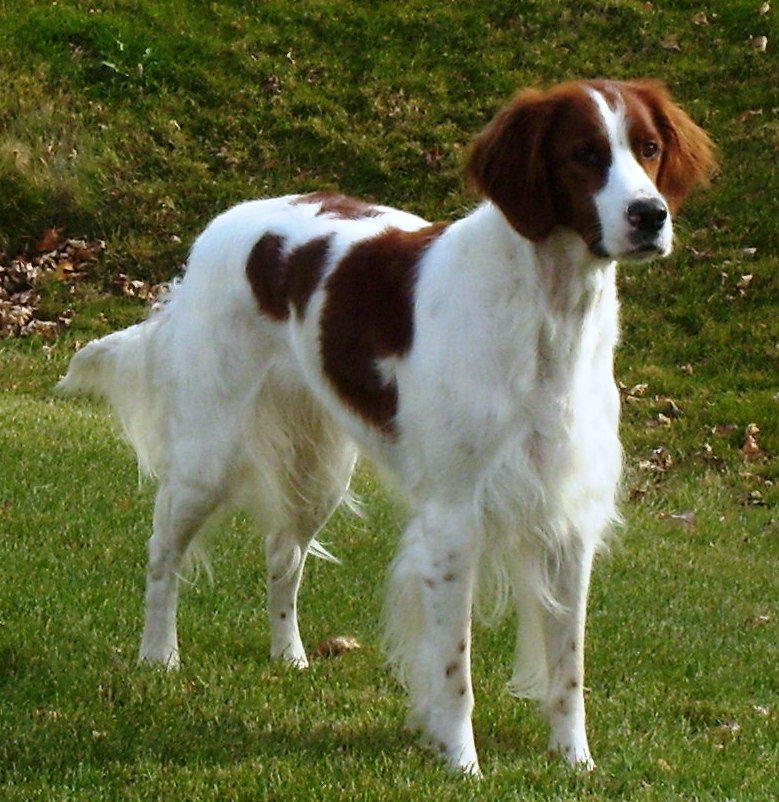
The Breed History
The Irish Red and White Setter was the predecessor of the solid red
Irish Setter, and was established in the 17th century from other
Setter, Pointer, and Spaniel breeds. By the end of the 19th century,
the popularity of the solid red Irish Setter eclipsed the Irish Red and
White, and they fell to near extinction. In 1920, Rev. Noble Huston
collected breed members, and a breed association was formed
in 1944. Mrs. Maureen Cuddy's efforts at establishing pedigrees
allowed the breed to be admitted to the Irish Kennel Club in 1978.
The breed is active in Field Trials and Shows. It attained full AKC
recognition in 2009.
Breeding for Function
The Irish Red and White Setter is bred primarily for the field. The
standard as set out hereunder must be interpreted chiefly from this
point of view and all Judges at Bench Shows must be encouraged
to judge the exhibits chiefly from the working standpoint. The
appearance is strong and powerful, well balanced and proportioned
without lumber; athletic rather than racy with an aristocratic, keen
and intelligent attitude.
Physical Characteristics
Height at Withers: Dogs 24.5-26 inches (62-66 cm). Bitches
22.5-24 inches (57-61 cm). Field dogs tend to be smaller than show
dogs.
Weight: 50-75 pounds (22.5 kg-34 kg).
Coat: The base color is white with solid red patches (clear islands
of red color). Flecking but not roaning is permitted around the face
and feet and up the foreleg as far as the elbow and up the hind leg
as far as the hock. Feathering is present on the back of the fore and
hind legs, on the outer ear flap, on the flank extending onto the
chest and throat forming a fringe, and on the tail.
Longevity: 11-15 years.
Points of Conformation: The length of the body from point of
shoulders to base of tail is not shorter than the height at the top
of the withers. Bone is moderate in proportion to size. The eyes
are round, and dark hazel or dark brown. The skull is broad in
proportion to the body and domed without showing an occipital
protuberance. The stop is distinct, but not exaggerated. The neck is
moderately long, very muscular, but not too thick. There is a level
topline. The body is strong and muscular with a deep chest and
well sprung ribs. The feet are close-knit with plenty of feathering
between toes. The gait is long striding, very lively, graceful and
efficient. The forelegs and hind legs move perpendicularly to the
ground with no crossing or weaving.
Recognized Behavior Issues and Traits
The Irish Red and White Setter is a very friendly, dependable and
easily trained gundog. The breed displays a kindly, friendly attitude,
behind which should be discernible determination, courage and
high spirit. His good and kind nature makes him a most acceptable
companion and friend in the home and the field. The Irish Red and
White Setter has a high activity requirement and needs a lot of
exercise.
Normal Physiologic Variations
None Reported
Drug Sensitivities
None Reported
Inherited Diseases
Canine Leukocyte Adhesion Deficiency (CLAD): An autosomal
recessive, fatal immunodeficiency disease found in Irish Red
and White setters. Affected dogs present with severe recurrent
infections, neutrophilia and low body weight. The mutation is the
same as in Irish Setters, showing a common ancestral origin. One
study in the US showed a 13% carrier frequency in the breed, and a
study in the UK showed a 7.9% carrier frequency.
Hip Dysplasia: Polygenically inherited trait causing degenerative
joint disease and hip arthritis. OFA reports 4.5% affected.
Elbow Dysplasia: Polygenically inherited trait causing elbow
arthritis. Too few Irish Red and White Setters have been screened by
OFA to determine an accurate frequency.
Progressive Retinal Atrophy (PRA, RCD-1): Autosomal recessive,
early onset rod, cone dysplasia form of PRA with an onset of
25 days of age, and progressing to blindness by one year old.
The mutation is the same as in Irish Setters, showing a common
ancestral origin. A genetic test is available. The frequency of carriers
in the breed has not been established.
von Willebrand's Disease Type 1 (vWD): Autosomal recessive
genetic disorder causing a mild bleeding syndrome. A direct genetic
test is available from the Animal Health Trust. Reported at a low
frequency in the breed.
Patella Luxation: Polygenically inherited laxity of patellar
ligaments, causing luxation, lameness, and later degenerative joint
disease. Treat surgically if causing clinical signs. Too few Irish Red
and White Setters have been screened by OFA to determine an
accurate frequency.
Disease Predispositions
Hypothyroidism: Inherited autoimmune thyroiditis. 12.5% positive
for thyroid autoantibodies based on testing at Michigan State
University. (Ave. for all breeds is 7.5%).
Distichiasis: Abnormally placed eyelashes that irritate the cornea
and conjunctiva. Can cause secondary corneal ulceration. Identified
in 7.79% of Irish Red and White Setters CERF examined by
veterinary ophthalmologists between 2000-2005.
Persistent Pupillary Membranes: Strands of fetal remnant
connecting; iris to iris, cornea, lens, or involving sheets of tissue.
The later three forms can impair vision, and dogs affected with
these forms should not be bred. Identified in 3.90% of Irish Red
and White Setters CERF examined by veterinary ophthalmologists
between 2000-2005.
Gastric Dilatation-Volvulus (Bloat, GDV): Life-threatening
twisting of the stomach within the abdomen. Requires immediate
veterinary attention. Irish Red and White Setters are at increased
risk versus other breeds. Dogs with the deepest thorax relative to
width have the greatest risk for GDV.
Cataracts: Anterior and posterior cortical cataracts predominate in
the breed. Identified in 2.60% of Irish Red and White Setters CERF
examined by veterinary ophthalmologists between 2000-2005.
Chronic Superficial Keratitis (CSK)/Pannus: Corneal disease
that can cause vision problems due to pigmentation. Treatment
with topical ocular lubricants and anti-inflammatory medication.
Identified in 2.60% of Irish Red and White Setters CERF examined
by veterinary ophthalmologists between 2000-2005.
Retinal Dysplasia: Focal retinal dysplasia and retinal folds are
recognized in the breed. Identified in 2.60% of Irish Red and White
Setters CERF examined by veterinary ophthalmologists between
2000-2005.
Iris Cysts: Fluid filled sacs arising from the posterior surface of
the iris, to which they may remain attached or break free and
float into the anterior chamber. Usually occur in mature dogs.
Can occasionally block the iridocorneal angle causing glaucoma.
Identified in 1.30% of Irish Red and White Setters CERF examined
by veterinary ophthalmologists between 2000-2005.
Isolated Case Studies
None Reported
Genetic Tests
Tests of Genotype: Direct test for Canine Leukocyte Adhesion
Deficiency is available from Optigen and the Animal Health Trust.
Direct test for Rcd-1 PRA is available from Optigen, and the Animal
Health Trust.
Direct test for vWD is available from the Animal Health Trust.
Tests of Phenotype: CHIC certification: Required testing
includes hip radiographs, CERF eye examination, thyroid profile
including autoantibodies, and genetic tests for Rcd-1 PRA and
Canine Leukocyte Adhesion Deficiency. (See CHIC Website: www.
caninehealthinfo.org)
Recommend elbow radiographs, patella evaluation, and cardiac
examination.
Miscellaneous
- Breed name synonyms: Red and White Irish Setter,
Parti-Colored Setter.
- Registries: AKC, UKC, KCGB (Kennel Club of Great Britain), ANKC
(Australian National Kennel Club), NKC (National Kennel Club), FCI.
- AKC rank: Became an AKC recognized breed Jan. 2009.
Entire studbook registered.
- Internet resources: Irish Red and White Setter Association:
www.irishredwhitesetterassociation.com
Irish Red and White Setter Club of Great Britain:
www.irishredandwhitesetterclub.com
Irish Red and White Setter Club of Canada:
www.irishredandwhitesetterclub.ca
Photo Gallery of Breed - Irish Red and White Setter - Dog Breed

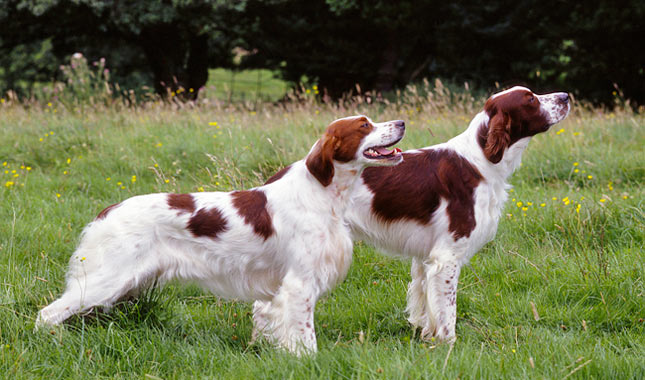
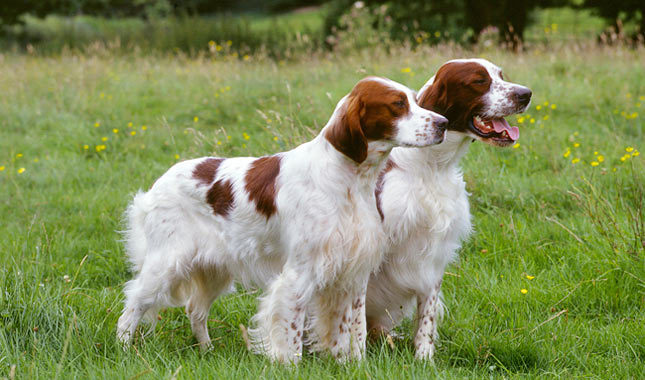



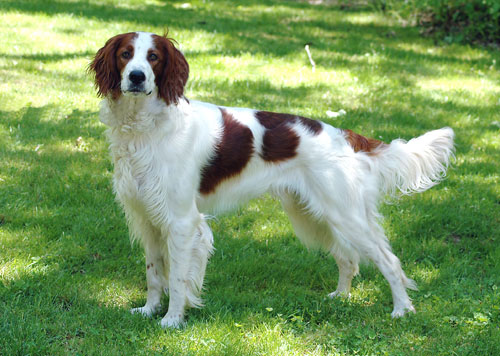
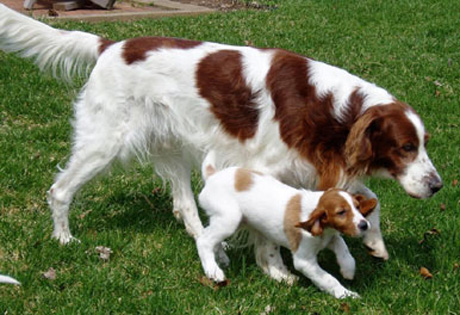
 Animalia Life
Animalia Life